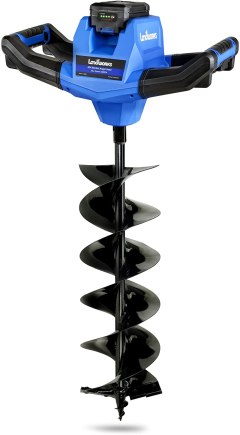BestReviews is reader-supported and may earn an affiliate commission. Details

Electric-powered model with a powerful battery and auger bits available in three sizes.
Electric-powered model with a powerful battery and auger bits available in three sizes.
Motor reaches 300 revolutions per minute. Rotates both ways. Eco-friendly and quiet. Three power motor settings. For lawns, yards, and gardens. Cordless motor.
Only comes with one battery, so an additional battery might be needed.

Durable, manual option with features that make your work more accurate.
Durable, manual option with features that make your work more accurate.
Oversized cushion grip for additional comfort. Durable hardwood handle resists wear and tear and attrition from cold. Engraved ruler. Blades spread 6.25 inches.
Blades are bolted to shaft rather than welded, so it may not be stable.

This 60-inch post-hole digger from Fiskars makes a tough job that much easier.
This 60-inch post-hole digger from Fiskars makes a tough job that much easier.
This manual post-hole digger is a great addition to your toolset as it will help you break up dense ground for posts, poles, and fencing. Sharpened blades make digging easier, and the offset handles help you get up to 12 inches deeper than other models.
Some buyers felt the length to be a bit unwieldy, so make sure it works for you before you buy.

A durable and rugged model that drills down to 36 inches.
A durable and rugged model that drills down to 36 inches.
Resists force and pressure in tough terrain. Comfortable, padded handles. Mitigates jarring and discomfort. Appeals to standard environmental safety regulations.
Difficult for smaller or less experienced users to operate.

Durable option that is also available with hardwood handles.
Durable option that is also available with hardwood handles.
Steel blades with rounded edges to carve precise holes. Has 48-inch handles. Ruler measurements on handle posts. Padded hand grips. Replaceable bolted handles.
The 48-inch handles may be too long for some users.

We recommend these products based on an intensive research process that's designed to cut through the noise and find the top products in this space. Guided by experts, we spend hours looking into the factors that matter, to bring you these selections.

Setting a pole or post in the ground requires you to dig a hole deep enough to hold the post/pole securely once the dirt has been shoveled back or you’ve poured concrete around it. The depth and width of the hole you need depends on the size and length of the post you’re putting in place.
The industry standard says you need to dig a post hole that is one-third as deep as your pole is long. If your pole is six feet long, you need to dig a post hole that is two feet deep. Additionally, the hole should be three times wider than the pole. Therefore, if your pole is four inches wide, the hole needs to be 12 inches wide.
Post holes need to have vertical sides as opposed to slanted sides in a V-shape. If water gets under the concrete and freezes, the expansion of the water will gradually force the concrete up and out of the hole. This means you need a post hole digger that will make deep holes with vertical sides.
We researched post hole diggers and found the best products on the market for your consideration. Read on for more information.

Post hole diggers have long been known as knuckle busters. Cushioned grips, or a larger spread between the handles in the closed position, is something to look at before you buy.
The larger and stronger the blades are, the better they’ll dig into the soil. Blades that are wide at the top and narrow to a point or semi-point at the bottom are better at digging through rough soil, gravel, and hard dirt than rounded blades. Rounded blades will grip ordinary soil better than pointed ones when you’re pulling the dirt out of the hole. Choose a post hole digger based on the type of dirt you’ll be digging through.
Smaller blades are advisable for digging small holes. If you’re installing a small decorative picket fence, for example, a smaller blade would probably work best. If you’re installing a heavy fence or a pole that will take some abuse, you’ll need to dig a bigger, deeper hole, necessitating larger blades on the post hole digger.
Post hole diggers are the kind of tools that take a great deal of abuse during their normal intended use. Occasionally, a post hole digger will break due to no fault of your own. Make sure the manufacturer offers a good warranty so you don’t have to buy a new tool if something happens.
A heavy post hole digger will bite deeper into the ground with each thrust than a lightweight one. Consequently, it will dig up more rocks and dirt than a lighter tool. It will also be harder to use as the day goes on. If you’re only digging one or two post holes now and then, go ahead and get the heavier post hole digger because it will dig holes faster.
If you’re digging a whole row of post holes, stop and consider how much upper body strength you have. Lifting five or six pounds up and down all day is easier than lifting 10 to 12 pounds for the same period of time. Even if you’re in good shape, those extra pounds can really make a difference over time. Give it some careful thought before making your decision.

For a long time, post hole diggers had heavy-gauge steel blades and wooden handles. The blades haven’t changed, but the handles have. Now you have some choices that will make a difference.
Hardwood handles: Most wooden handles are hardwood of some kind, usually hickory. They’re strong and lightweight. If you leave them out in the sun, they won’t take any damage from the sun’s UV rays. They’re susceptible to the weather, though. Humidity can cause the wood to rot, and too much heat can make the wood crack and splinter.
The spread of the blades refers to the distance between the tips of the blades when you drive them into the ground. The wider the spread, the easier it will be to dig a wide post hole. It will also scoop up more dirt each time you close the blades.
The depth of a post hole depends on how long the post hole digger’s blades are and where they are jointed. The longer the blades, the deeper you can dig before reaching the point where the handles start hitting the sides of the hole when you’re closing the blades.
The blades on post hole diggers are almost always powder-coated black. Wooden handles will be stained to protect them from the weather, but otherwise, they usually aren’t painted. Since the advent of fiberglass handles, there have been some choices in terms of color. The main colors are black, blue, red, and yellow. Occasionally, there will be some orange handles.
The low price point on post hole diggers is anything from $25 to $35. These are basic post hole diggers with wooden handles and no rubberized grips or added features.
Most post hole diggers sit in the $35 to $50 range. Rubberized grips, fiberglass handles, and heavy-duty blades are often found in this category.
The high price range for post hole diggers is anything above $50. Some of these tools have an all-steel construction and an advanced handle design that may increase the depth of the hole you can create.
Always call the gas and electric companies before you start digging post holes. If you cut one of their lines, it’s not only dangerous, it can also be very expensive because they’ll probably send you a bill for the damages.
On each thrust into the ground, turn the blades 90 degrees from the previous thrust. This lets you avoid hitting the same rock or gravel every time. It also loosens the hard soil by attacking it from all four directions of the compass.
When using straight handles, grip both handles together in both hands on the downward thrust. Once the blades have bitten into the ground, you can put a hand on each handle to pull them apart and close the blades together. This avoids the knuckle buster action that is so common when using post hole diggers.
If the ground is exceptionally hard, moisten it with water 30 minutes before trying to dig a post hole. Don’t soak the ground, or you’ll be digging through mud, and the sides of the holes will collapse. Moisten the ground just enough to loosen it.

Q. Do I need to call the gas/electric/cable companies if I’m replacing an existing fence?
A. Yes. Regulations usually require you to call because you may be digging deeper than the previous post holes, or a gas/electric/cable line may have been laid next to your existing fence after it was built. You always need to call before digging.
Q. How long does it take to dig a post hole?
A. It depends on the type of soil you’re digging in. Rough, rocky soil or hard clay will take longer than soft dirt or loam. In softer dirt, you’ll probably need about 10 minutes per hole. In hard dirt or clay, it could take up to half an hour per hole or more.
Q. Can the handles on a post hole digger be replaced?
A. Yes. Replacements for wooden handles can be found at most hardware stores. Those are usually generic. If your post hole digger has anything other than straight handles, you’ll have to order them from the manufacturer.
Get emails you’ll love.
Learn about the products you’re wondering if you should buy and get advice on using your latest purchases.
